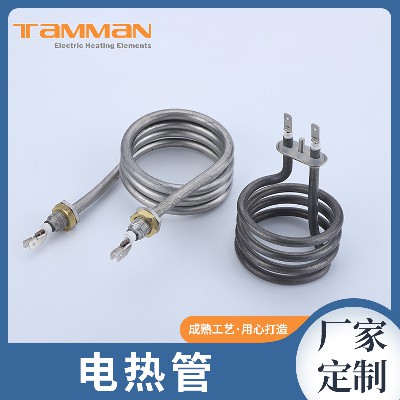Heating pipe manufacturer: introduction to resistance heating principle of heating pipe
The electric heating tube is generally divided into direct resistance heating. Originally, it is very simple: the power supply voltage is directly added to the heated object. When the current flow expires, the heated object itself will be heated by the electric heating ironing machine.
Objects that can be directly heated by resistance need to be conductors, but they should have high resistivity. Since the heat is generated from the heated object itself and belongs to internal heating, the thermal efficiency is very high. Direct resistance heating requires heating elements made of special alloy materials or non-metallic materials. The heat energy generated by the heating elements is transmitted to the heated object by means of radiation, convection and conduction. Since the heated object and the heating element are divided into two parts, the type of heated object is generally unrestricted and the operation is simple.

The electric heating tube is the material used for the heating element directly heated by resistance. Generally, the electric heating tube requires high resistivity, small resistance temperature coefficient, small deformation at high temperature and is not easy to embrittle. Commonly used are iron aluminum alloy, nickel chromium alloy and other metal materials and silicon carbide, molybdenum disilicide and other non-metal materials.
The higher operating temperature of metal heating element can reach 1000 ~ 1500 ℃ according to the type of material; The higher operating temperature of non-metallic heating elements can reach 1500 ~ 1700 ℃. The latter equipment is convenient and can be replaced by a hot furnace, but it requires pressure regulating equipment during operation. Its service life is shorter than that of alloy heating elements. It is generally used in high-temperature furnaces, local and some special occasions where the temperature exceeds the allowable higher operating temperature of metal heating elements.
Article source: heat pipe manufacturerhttp://www.gdtamman.com
-
04-23
Manufacturer of heating pipe: what is the maximum design temperature of electric towel rack
What is the design temperature of the electric towel rack?As a fashionable household bathroom appliance, it can go deep into people's homes. Naturally, it has its common function and strong pract
-
02-25
Zhongshan heating pipe: what is the relationship between the surface load and the service life of the heating pipe
The external load of the electric heating tube has a direct relationship with the service life of the electric heating tube. Different external loads should be adopted in the design of electric heatin
-
01-07
Heating tube manufacturer: knowledge about electric heating tube filler
Have many friends who don't know much about electric heating tubes ever had such questions? Is the electric heating tube solid? Why is the surface of electric heating tube not charged?Many friend
-
12-08
Manufacturer of heating pipe: cracking and inspection of stainless steel electric heating pipe
The stainless steel electric heating tube is sheathed with stainless steel, with magnesium oxide rod as the inner core, with magnesium oxide powder as the filler, and with nickel chromium wire as the